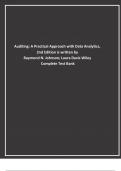Examen
Test Bank for Auditing A Practical Approach with Data Analytics, 2nd Edition by Raymond N. Johnson; Laura Davis Wiley Complete .pdf
- Grado
- Institución
Excel in Auditing with the Test Bank for Auditing: A Practical Approach with Data Analytics, 2nd Edition by Raymond N. Johnson and Laura Davis Wiley! Are you preparing for your auditing courses and seeking a comprehensive study resource? This test bank is your key to mastering the material and exc...
[Mostrar más]



